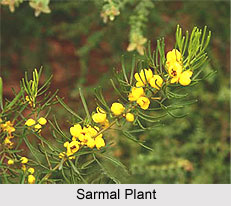 Sarmal, an Indian Medicinal Plant, is a sub-erect, prostrate or erect herb having numerous stems, spreading at about 30 cm long. "Nallajiluga", the name of Sarmal in Telugu and "Dodda" in Kannada, is extensively distributed throughout India at an altitude of about 2100 meters. The botanical name of this herb is "Cassia Pumila". It is used as a soil cover plant. It is also planted between the rows of other plants to prevent soil erosion in some parts of the world. The Sarmal plants are short-lived and it grows well from the months of August to September.
Sarmal, an Indian Medicinal Plant, is a sub-erect, prostrate or erect herb having numerous stems, spreading at about 30 cm long. "Nallajiluga", the name of Sarmal in Telugu and "Dodda" in Kannada, is extensively distributed throughout India at an altitude of about 2100 meters. The botanical name of this herb is "Cassia Pumila". It is used as a soil cover plant. It is also planted between the rows of other plants to prevent soil erosion in some parts of the world. The Sarmal plants are short-lived and it grows well from the months of August to September.
Characteristic Features of Sarmal
The branches of Sarmal are slender and covered with white hairs. The leaves of this herb are about 2 to 5 cm long, rachis hairy, common petiole of 3 to 4 mm long with a stalked gland on the petiole just beneath the leaflets; the stipules are 5 mm long, lanceolate, acute; leaflets of 10 to 20 pairs, 6 to 13 mm long and 2.5 to 3 mm in width, linear-oblong, extremely unequal-sided, apex is rounded and apiculate, nerves conspicuous under. The flowers of this medicinal plant is yellow in colour and it is singular or in groups of 2 to 3, supra-axillary; pedicels are very short and slender; bracts are under the pedicels lanceolate; calyx is divided to the base, 2.5 to 3 mm long, pubescent, segments oblong-lanceolate, sub-equal, acute; petals are of 4 mm in length, yellow, tender, obovate-cuneate, veined. Petals very unequal, narrowly oblong to broadly orbicular and retuse, 3-5 mm long, narrowed towards the base, nearly clawed. Pods are 2.5 to 3.8 cm in length and 0.4 to 0.5 cm in width, having oblique partitions in the middle of the seeds, flat, linear, glabrous or with a few scattered hairs; seeds are brown, obovoid-cuneate, rectangular, compressed and shiny. The seeds have a hard seed coat that is impermeable to water, and which prevents the seed from imbibing. Cassia Pumila seeds will usually germinate in 7-90 days.
Medicinal Values of Sarmal
Sarmal is believed to possess depressant activity. The seeds of this herb are at times used as a purgative.











